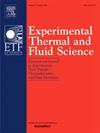表面条件对过冷水中钢瓶淬火沸腾传热影响的实验研究
IF 2.8
2区 工程技术
Q2 ENGINEERING, MECHANICAL
Experimental Thermal and Fluid Science
Pub Date : 2025-02-18
DOI:10.1016/j.expthermflusci.2025.111446
引用次数: 0
摘要
本研究对SS、FeCrAl和Zr-4钢瓶在蒸馏水中淬火沸腾进行了对比实验,考察了它们的流动和传热性能。采用高速摄像机对其瞬态淬火沸腾行为进行了观察。采用已验证的反热传导问题(IHCP)方法,根据圆柱体内部温度的测量,得到了表面温度和热流密度。实验结果表明,在冷却剂过冷度增大、表面粗糙度增大、固体材料热物性乘积ρkcp减小的情况下,淬火沸腾持续时间缩短,最低膜沸腾温度Tmin升高,传热性能增强。此外,冷却剂过冷度对淬火沸腾过程的影响比表面粗糙度的影响更为显著。粗糙表面的微米级微观结构对气膜的换热影响很小,但会引发气膜的早期坍塌,提高Tmin。值得注意的是,在实验中较低过冷度5℃条件下,粗糙表面和光滑表面的气膜坍缩类型存在显著差异,即相干坍缩和传播坍缩。与SS和FeCrAl相比,Zr-4的淬火传热更容易受到表面氧化的影响。此外,还建立了一种新的Tmin相关性,该相关性耦合了表面粗糙度、冷却剂过冷度和固体热物理性质的影响,大多数预测值在10%的误差范围内。本文章由计算机程序翻译,如有差异,请以英文原文为准。
Experimental investigation on the influence of surface conditions on boiling heat transfer during quenching of a cylinder in subcooled water
In this study, comparative experiments were conducted on the quenching boiling in distilled water of SS, FeCrAl and Zr-4 cylinders to investigate their flow and heat transfer performance. The high-speed camera was used to visualize the transient quenching boiling behavior. By employing the validated inverse heat conduction problem (IHCP) method, the surface temperature and heat flux were obtained based on measured temperature inside the cylinder. The experiment results indicate that within the increase of coolant subcooling degree, surface roughness, and decrease of the product of the thermophysical properties of solid materials (ρkcp), the duration of quenching boiling decreases, the minimum film boiling temperature (Tmin) increases, and the heat transfer performance is enhanced. Moreover, the influence of coolant subcooling degree on quenching boiling process is more pronounced than that of surface roughness. The micron-scale microstructure of the rough surface has a minimal effect on the heat transfer of the vapor film, but it triggers the early collapse of the vapor film and raises Tmin. It is noteworthy that under the lower subcooling condition of 5℃ in the experiment, there are notable differences in the types of vapor film collapse between the rough surface and smooth surface, namely Coherent Collapse and Propagative Collapse. Compared with SS and FeCrAl, the quenching heat transfer of Zr-4 is more susceptible to surface oxidation. Furthermore, a new correlation for Tmin is developed, that couples the influence of the surface roughness, coolant subcooling degree, and solid thermophysical properties, with most predicted values falling within a 10% margin of error.
求助全文
通过发布文献求助,成功后即可免费获取论文全文。
去求助
来源期刊

Experimental Thermal and Fluid Science
工程技术-工程:机械
CiteScore
6.70
自引率
3.10%
发文量
159
审稿时长
34 days
期刊介绍:
Experimental Thermal and Fluid Science provides a forum for research emphasizing experimental work that enhances fundamental understanding of heat transfer, thermodynamics, and fluid mechanics. In addition to the principal areas of research, the journal covers research results in related fields, including combined heat and mass transfer, flows with phase transition, micro- and nano-scale systems, multiphase flow, combustion, radiative transfer, porous media, cryogenics, turbulence, and novel experimental techniques.
 求助内容:
求助内容: 应助结果提醒方式:
应助结果提醒方式:


